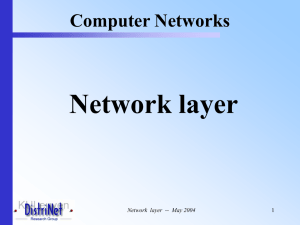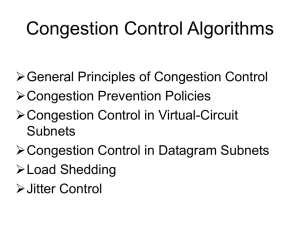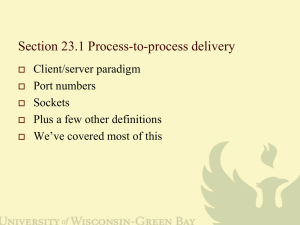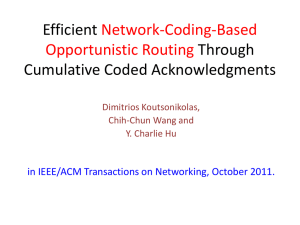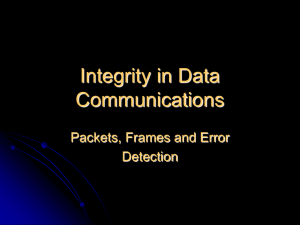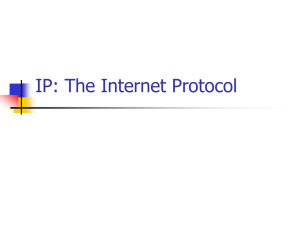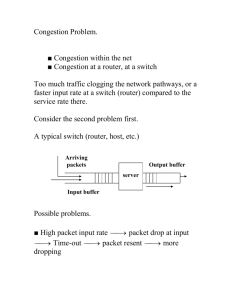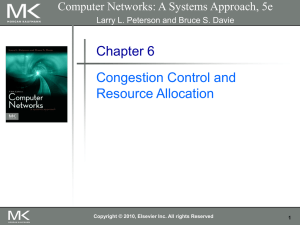Congestion control Algorithms
advertisement
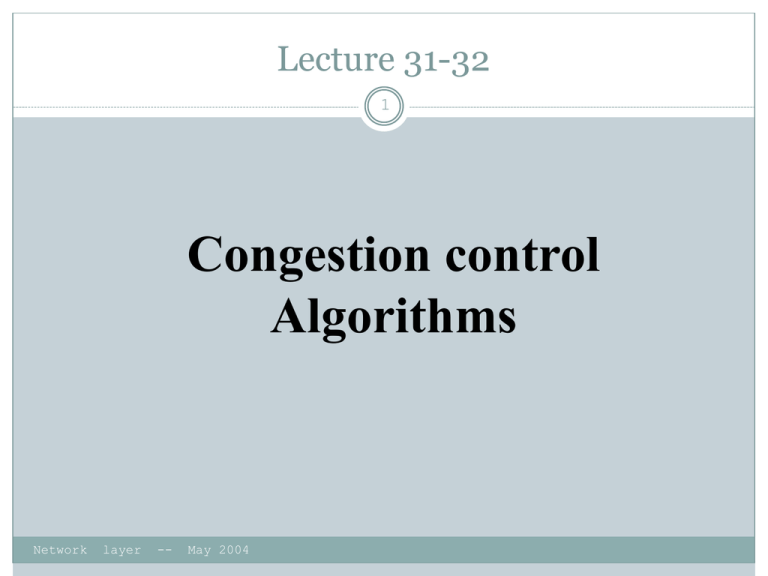
Lecture 31-32 1 Congestion control Algorithms Network layer -- May 2004 Congestion Control Algorithms 2 Design issues General principles of Routing Congestion Internetworking Internet Protocols Network layer -- May 2004 congestion control Prevention policies Handling virtual circuit subnets General techniques Load shedding Jitter control Congestion? 3 Too many packets in (a part of) the subnet! Network layer -- May 2004 Congestion? 4 Too many packets in (a part of) the subnet! caused by the same output line is used by many input lines mismatch between system parts slow processor low bandwidth lines tends to feed upon itself Congestion control <> flow control Congestion: global issue ( subnet is able to carry the traffic) Flow control: point-to-point ( control the traffic between a given sender and reciever) Network layer -- May 2004 Congestion: principles 5 Control theory viewpoint: dividing all the solutions to two groups open loop closed loop: feedback loop How? Good design Make sure the problem does not occur Tools Decide when to accept traffic Decide when to discard packets and which ones Make scheduling decisions in the subnet They make decision without considering current state of network Monitor: where and when congestion? % packets discarded average queue length number of packets that time out average packet delay Rising no. Indicate growing congestion Pass collected info to places where actions can be taken = source of traffic explicit <> implicit feedback explicit: (extra) packet, flags (in other packets), probe packets ( ex. Radio stations have flying halicopters) Adjust system Network layer -- May 2004 operation Increase resources: bandwidth Decrease load: deny, degrade service Network Layer 6 Design issues Routing Congestion Internetworking Internet Protocols Multimedia or QoS Network layer -- May 2004 General principles Prevention policies Handling virtual circuit subnets General techniques Jitter control Congestion: prevention 7 open loop solutions: Minimize congestion, they try to achieve there goals by using appropriate policies at various levels Layer Transport Policies Retransmission policy Out-of-order caching policy Acknowledgement policy Flow control policy Timeout determination ( transit time over the network is hard to predict) Network Virtual circuits <> datagrams in subnet( many cog. Control algo work only with VC) Packet queueing and service policy ( 1 Q / input/output line and round robin) Packet discard policy Routing algorithm ( spreading traffic over all lines) Packet lifetime management Data link Retransmission policy( Go back N will put heavy load than Selective Reject) Out-of-order caching policy ( Selective repeat is better ) Acknowledgement policy( piggyback onto reverse traffic ) Flow control policy ( small window reduce traffic and thus congestion ) Network Layer 8 Design issues Routing Congestion Internetworking Internet Protocols Network layer -- May 2004 General principles Prevention policies Handling virtual circuit subnets General techniques Jitter control Virtual circuit subnets 9 Dynamic approach: act when needed , closed loop solutions Admission control No new virtual circuits when congestion is signalled e.g. telephone network : when a switch gets overloaded , it also practice admission control by not giving dial tones. Route new virtual circuits around problem areas Virtual circuit subnets 10 Dynamic approach Admission control Route new virtual circuits around problem areas Negotiation when virtual circuit is set up About kind of traffic + service desired Resource reservation in subnet Line capacity Buffers in routers No congestion Unused resources Network Layer 11 Design issues Routing Congestion Internetworking Internet Protocols Multimedia or QoS Network layer -- May 2004 General principles Prevention policies Handling virtual circuit subnets General techniques Jitter control General techniques( can be used in Datagram network and Virtual Circuit as well) 12 Approaches: reduce traffic by Requesting senders local measurements + info packets to senders + hope for …. Throwing away packets local measurements + local actions to reduce load Network layer -- May 2004 Source based approach 13 Basic algorithm Router monitors utilisation of output lines u recent utilisation: 0 u 1 f Instantaneous line utilisation good estimate of u a constant unew = a uold + (1 – a ) f In case of overload: unew > threshold Output line enters warning state Some action is taken: Warning bit Choke packets Hop-by-hop choke packets Network layer -- May 2004 Source based approach 14 Warning bit Output line in warning state Algorithm at source As long as router is in warning state, warning bits arrive at source: reduce traffic Less warning bits: increase traffic Problems Warning bit set in packet header Destination copies bit into next ack Source cuts back traffic voluntary action of host! correct source selected? Used in Network DecNet Frame relay layer -- May 2004 Source based approach 15 Choke packet: Tell host directly to slow down In case of overload: router sends choke packet to host causing the overload Host receiving choke packet reduces traffic to the specified destination ignores choke packets for a fixed interval new choke packets during next listening interval? Yes: reduce traffic No: increase traffic Problems: voluntary action of host! correct host selected? Source based approach 16 Choke packets: Example showing slow reaction Solution: Hop-by-Hop choke packets Network layer -- May 2004 Source based approach 17 Hop-by-Hop choke packets Network Have choke packet take effect at every hop Problem: more buffers needed in routers layer -- May 2004 Load shedding 18 It is a fancy way of saying that ::::Throw away packets that cannot be handled!! Packet selection? Random Based on application File transfer: discard new packet( out of order problem - wine) Multimedia: discard old packet ( milk ) Let sender indicate importance of packets Low, high priority Incentive to mark a packet with low priority Price Allow hosts to exceed agreed upon limits Random early detection … Load shedding 19 Throw away packets that cannot be handled!! Packet selection? Random early detection Discard packets before all buffer space is exhausted( response to lost packet is for source to slow down- ex- TCP for wired network) Routers maintain running average of queue lengths ( to determine when to start discarding ) Select at random a packet Inform source? Send choke packet? more load!! No reporting When does it work? Source slows down when packets are lost This approach can not be used in wireless networks Network Layer 20 Design issues Routing Congestion Internetworking Internet Protocols Network layer -- May 2004 General principles Prevention policies Handling virtual circuit subnets General techniques Jitter control Congestion: jitter control 21 Important for audio and video applications? not delay variance of delay Congestion: jitter control 22 Jitter = variation in packet delay Compute feasible mean value for delay compute expected transit time for each hop router checks to see if packet is behind ahead schedule behind: forward packet asap ahead: hold back packet to get it on schedule again Buffering? Depends on characteristics: Video on demand: ok Videoconferencing: nok Network layer -- May 2004 Network Layer 23 Design issues Routing Congestion Internetworking : Next Lecture Network layer -- May 2004
